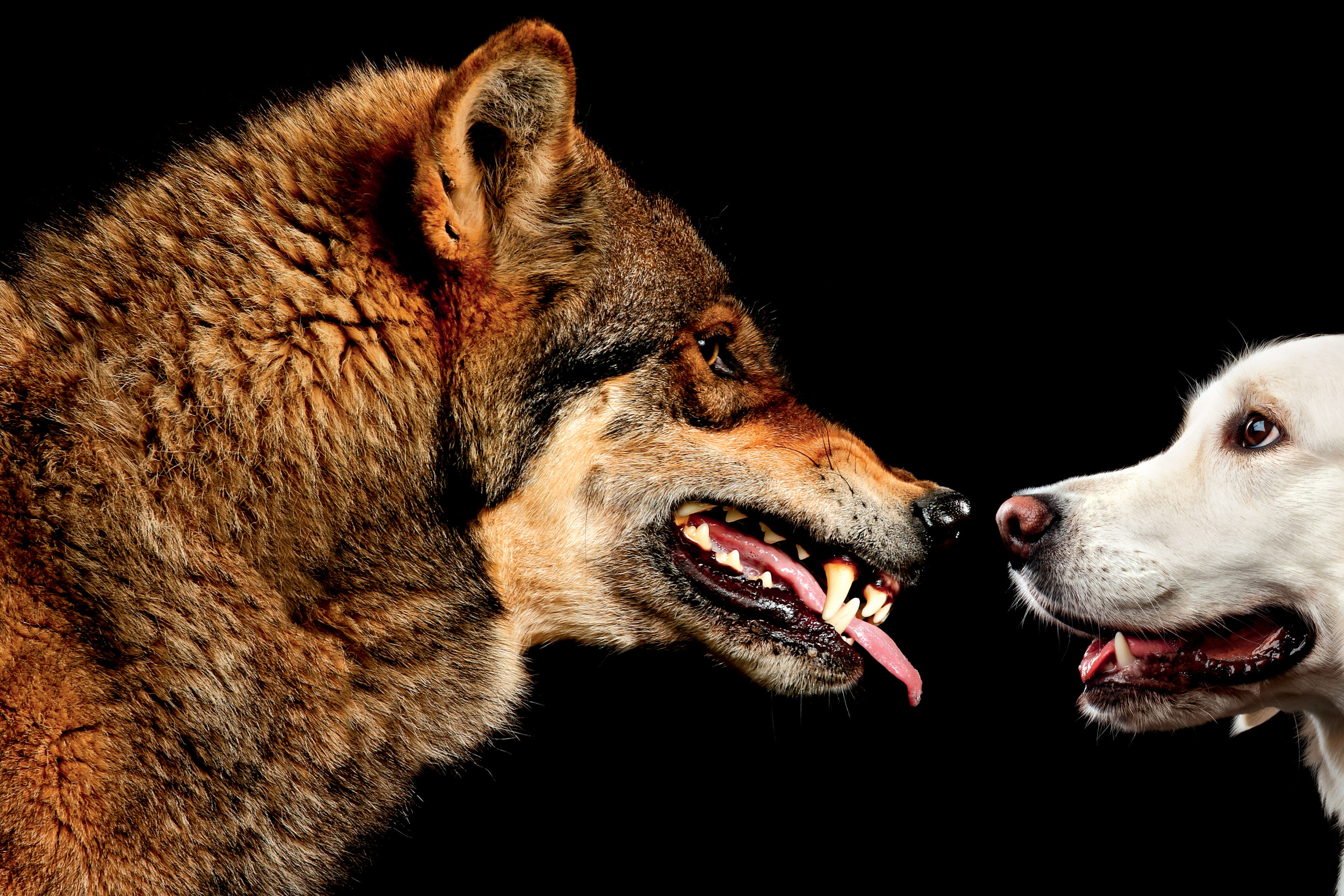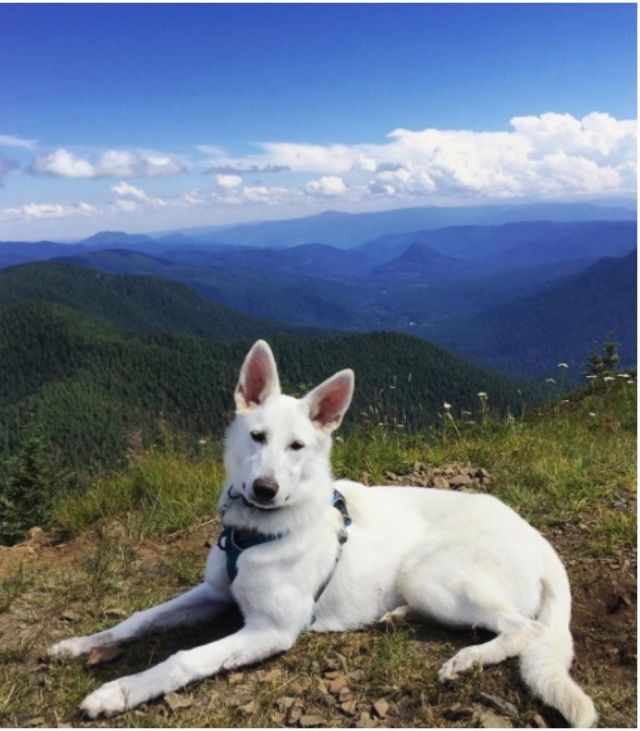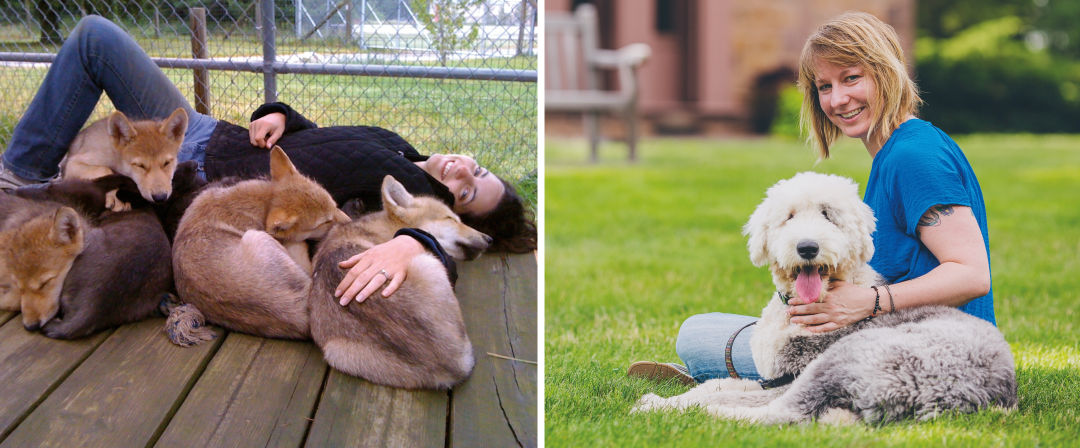
Wolf. Dog. What’s the Difference?
Snowy white fur gathers around her head and neck like a medieval coronation cloak, framing ochre, olive-shaped eyes and massive, upturned, pink-lined, magnolia petal ears. Her arms and legs are muscular and lithe, like the physique of a Tour de France competitor.
Luna is a rare, wild beauty. For a while, I (like generations of romantic dog owners before me) wondered if she might be “part wolf,” harboring moon-howling DNA from parents, great-grandparents, distant ancestors. Much to the chagrin of a dozen-odd trainers of varying philosophies, she has feared unfamiliar humans since birth, reacting with terrifying aggression. Her dog-on-dog “play behavior” looks like canine jujitsu, as she wraps her mouth around other dogs’ necks, pinning them to the ground. On walks, she pulls like Balto on a life-saving mission, not a dog with several years of polite leash training under her collar.
I know Luna is not a wolf. She is a fancy, inbred Swiss shepherd with serious behavior issues (and a heart of gold). But still I wonder: what makes her so unlike the friendly neighborhood pug, motoring around by its corkscrew tail; so maladjusted, compared to the slap-happy retrievers sprawled on brewery patios? More to the point, how can Luna seem—even to me, the human who knows her best—so much like a lupine huntress stalking the Siberian wilds, yet still be a dog? For all her off-the-hook antics, the girl still curls up by my feet at night and would not last without probiotic-packed, bison-rich kibble.
And so to the eternal mystery: what divides wolf from dog, and how did we get from one to the other? Luna poses one version of the problem; your yappy Pekingese, Napoleon complex min pin, or circus-act bichon frise may pose another. Rambunctious or placid, it’s hard to imagine how roaming pack predators turned into all of these things.

Luna
Image: Benjamin Tepler
Monique Udell thinks she knows the answer—or, at least, a key part of it, which may help explain not only how wolves became dogs but why some dogs (Luna!) seem more wolfish than others. Udell, assistant professor of animal and rangeland sciences at Oregon State University, is an expert in canine cognition and behavior. In 2013, she founded OSU’s Human-Animal Interaction Lab, where she attempts to vault the animal kingdom’s many language barriers. (Can cats be trained to walk on a leash? Yes. Can bats follow direction? The answer will floor you.)
The question of dog and wolf naturally preoccupies her. “With wild canines, there are so many mixed feelings,” says Udell. “We look at dogs, which are incredibly closely related. They thrive all around the world with intense human bonds. In some places, they live on the streets scavenging trash. In others, they are in our homes—we trust them with our lives.” In July 2017, along with several collaborators, Udell published a groundbreaking paper on the subject in the journal Science Advances.
Boiled to its essence, the thesis argues that domesticated dogs are wolves ... with a developmental disorder.
Udell, at 34, has attained the kind of media recognition other researchers might covet. In 2007, while she was in grad school at the University of Florida, her adviser received an email from reputed canine biologist Raymond Coppinger. Coppinger, who died last year, was connected to Wolf Park, a Battle Ground, Indiana, facility where humans raise wolves from a few weeks of age until adulthood as part of one of the world’s only wolf socialization programs. The park, established in 1972 as a laboratory of lupine behavior and communication, spent decades developing a unique regimen that allows humans to safely interact with the wild, reclusive hunters.
Udell’s early research, which examined dogs’ ability to follow human gestures, had caught Coppinger’s eye. After years of observation at Wolf Park, he suspected human-socialized wolves could follow those same human gestures even better than dogs, a notion contrary to reigning canine evolutionary theory: that dogs could understand actions like pointing, eye-gazing, and head-turning about as well as a human child, whereas wolves, it was thought, could not.
Udell visited the 110-acre park—a grassy, pond-pocked midwestern habitat lined with 10-foot fences and perpetually packed with tourists and elementary school students. In 2008, in the journal Animal Behaviour, she published one of the first studies to argue that socialization and life experience—not genetics—gifted Canis familiaris its unique task-following ability around humans.
In 2010, Udell raised her first Wolf Park litter. Socializing wolves is a full-time endeavor: imagine a typical troop of unruly puppies, but moving at breakneck speed. Pups are obtained at 10 to 14 days of age, mostly from zoos or sanctuaries. For the first six weeks, Udell went full den mother: three hours of bottle-feeding, butt-wiping, and coddling, followed by three hours of sleep—on repeat. By eight weeks, when dog puppies are still wobbly, helpless, and heading to human homes, wolf pups can live entirely outside and shift to a meat-eating diet. Soon, she began training her litter to sit, stay, walk on a leash, and ride in cars. “After eight or nine weeks, you have to be able to feed them without being mobbed,” she explains, citing the danger otherwise.
Adolescent wolves are everything you might expect. Search “Wolf Park” on YouTube for a veritable Game of Thrones reverie: packs of 100-pound wolves howling at the moon and nosing photographers. Udell spent several months with her litter in 2010, and with a second litter in 2012.
“It’s hard to leave,” she admits. “But the work I do, I’m constantly entering into relationships with animals that aren’t mine. They’ll never be my pets. You kind of deal with the fact that you won’t get to see some of them again.”

Monique Udell (left) in 2012, with her second litter at Wolf Park in Battle Ground, Indiana; Bridgett vonHoldt sits with her own Old English sheepdog, Marla, on a lawn at Princeton in New Jersey
Image: Courtesy Monique Udell and Courtesy Chris Fascenelli
When she’s not teaching Oregon State students, Udell spends much of her lab time watching dogs just being dogs. Often, that looks like a stubby dachshund waddling around a closed Tupperware container of summer sausage in an empty classroom. Access to that summer sausage is just a rope-tug away, but the wiener dog can’t quite decode the puzzle. It’s too busy staring at the door, waiting for a human to come in. When someone does enter, it’s game over: the dog is a wagging, elated mess. Using volunteered pet dogs and a small lab in Withycombe Hall, Udell collects data on everything from attachment style and social development to problem solving.
One of her main takeaways? Dogs fail at seemingly simple tests because they’re too fixated on humans to think straight.
In 2014, Udell met Bridgett vonHoldt at a conference at Princeton. VonHoldt has spent the past 14 years studying canine evolutionary genetics. In 2010, she published one of the first papers to compare the genomes of dogs and wolves side by side. “The most significant difference was an unannotated, uncharacterized gene in an unknown location,” explains vonHoldt. “The next most significant difference was a mutation in a gene called ‘Williams-Beuren chromosome region number 17.’”
For some time, Udell had wondered about a connection between the dog-wolf divide and what is, in humans, called Williams-Beuren syndrome, a grab bag of a genetic disorder. In people, the deletion of genes dominos into multiple systems and organs, often resulting in an elfin appearance, changes in nose structure, and a higher risk for cardiac defects. Behaviorally, people with the syndrome tend to be friendly and sociable to a prohibitive degree, to the point that performing tasks while another person is in the room presents a challenge. “Stranger danger” is nonexistent; everybody is a good friend. WB-affected people have a long developmental delay compared to children without the syndrome.
You can’t equate a human and a canine, obviously. But Udell wondered if the fixations on people she witnessed in dogs in her lab could be a manifestation of WB.
For vonHoldt, her discovery of genetic alterations on the canine WB region was a breakthrough. “We are looking at very few mutations that can result in this phenotype,” she says, referring to the outward, observable effects of a genetic trait. “That’s like a gold mine for a geneticist. I asked myself, could this one bit of a chromosome that’s being altered, and poked at, and messed with be the foundation for creating a domestic dog? It seemed like someone just needed to look.”
Over coffee, the two scientists hatched a plan. Udell performed her sociability and problem-solving tests on 18 domestic dogs at her Corvallis lab and 10 human-socialized Wolf Park wolves in Indiana. Next, she took blood samples from each subject and shipped them, on ice, to vonHoldt in New Jersey, who sequenced the genomes.
Together (and with coauthors), they published one of the first studies to use behavioral observation and genomic methods to pinpoint the “domestication genes” that make dogs act differently from wolves. Some of the results lined up like pieces of a jigsaw. Only two of 18 dogs were successful in solving a simple puzzle, ostensibly due to their WB-like fixation on humans. Eight out of 10 wolves succeeded at the same task. At median, the socialized wolves spent only 35 percent of their time in close proximity to humans; the dogs, 65 percent.
But the results were far from cut-and-dried: Instead of finding that all dogs have these genetic mutations and that all wolves do not, the scientists found a spectrum.
Some wolves do have these mutations; some dogs have it to a lesser degree, while others have it in spades. “It’s as though we’ve taken a friendly wolf and magnified it 10 times,” says vonHoldt. “And that’s a dog. Then we magnified that some more to turn a regular dog into a Labrador retriever, or a golden.”
The researchers took things one step further, predicting that certain types of dogs should show more WB mutations than others. They took the genetic data of 217 domestic dogs and 78 wild canines or feral dogs and compared them to their basic behavioral profiles from the American Kennel Club (e.g., goldens are friendly, huskies are aloof). The results showed, loosely, that “attention-seeking” dog breeds did have more mutations, as predicted.
All told, the study posits that the WB mutation alone doesn’t neatly separate wolf from dog. The resulting effects’ mildness or severity might make some friendly wolves less aloof to humans. Overall, it might make dogs more sociable than their wild counterparts. And, perhaps, the degree of WB mutation is what makes a German shepherd less of a party animal than a black Lab.
The research, amplified by many science publications across the country, Smithsonian to National Geographic, offers one of the most convincing theories for canine domestication thus far. Maybe, instead of our prehistoric ancestors snatching a feral wolf pup 14,000 years ago, and spending millennia turning its progeny into safe, pliable companions, they had a little help from the Williams Beuren mutations.
“There’s no reason to reinvent the wheel,” says vonHoldt. “If you have a wolf hanging around your local community, eating scraps, it’s already tolerant of humans. If you can control it, you can magnify and amplify that effect. It’s just like Gregor Mendel and his peas.”

This being science, there are nuances and caveats. In particular, other notable researchers in the field are not totally convinced by Udell and vonHoldt’s reliance on information from the American Kennel Club—essentially a huge hobbyist association of dog lovers—rather than behavorial information about specific dogs. Still, other researchers tend to recognize Udell and vonHoldt’s work as a potentially intriguing advance.
Anna Kukekova, an assistant professor of genetics and social behavior at the University of Illinois, is investigating the genetic mechanisms behind the domestication of foxes.
“That was an important paper,” says Kukekova. “It’s really an indication that these genetic regions indeed differentiate dogs and wolves. Something is going on there.”
Kukekova’s lab doesn’t just study any foxes—it studies the famous silver foxes of Novosibirsk, Russia, where, in 1959, a geneticist named Dmitry Belyaev began one of history’s most important studies of evolution and domestication. Belyaev had fallen afoul of Stalin’s regime, which persecuted geneticists for Stalin-ish reasons. (For decades, official Soviet theory held that life experiences, not genes, passed from generation to generation. A bodybuilder’s kid would be yoked from birth, et cetera.) Undeterred, he took over the Institute of Cytology and Genetics, breeding the silver fox (farmed for fur coats) over and over again to observe physical and behavioral development—essentially a sped-up, human-rigged version of natural selection. Along with fellow scientist Lyudmila Trut, Belyaev bred separate strains of friendly and extra-ornery foxes, keeping the aggressive strand as a benchmark Hyde to the docile Jekyll.
Today, the lab’s friendliest foxes are as tame as a drooling St. Bernard, with familiar physical changes, like floppy ears, spots, and a curly tail. One of the storied institution’s greatest goals? To uncover the genetic trigger for domestication.
Belyaev died in 1985. Kukekova has collaborated with Trut since 2002, collecting blood samples from the nearly 60-year-old line of foxes in search of genes that relate to domestication. “We are looking at these same regions in foxes to see if we find anything, but it’s still preliminary,” says Kukekova. Interestingly, in her 2018 paper published in Nature Ecology & Evolution, she compared the genetic profiles of the domesticated foxes both docile and aggressive, and found a WB mutation present for the aggressive foxes. Although, she explains, “In foxes, there can be other mutations, not the same structural variants, but they may affect the same genes.”
Kukekova remains cautious about the scope of Udell and vonHoldt’s conclusions. “They got a behavioral score for wolves and a small subset of dogs, but that’s not enough,” she argues. “They just took scores provided by the American Kennel Club, and that’s the real limitation of this study. We don’t really have methods which would allow us to predict the behavior of dogs. Even in golden retrievers, considered to be very social, there is a proportion that shows pretty aggressive behavior.”
Sarah Marshall-Pescini, a half-Italian, half-English scientist who spent her formative years studying primate behavior in Uganda, is a senior researcher at Vienna’s Wolf Science Center, the world’s other human-friendly wolf park. She also studies the mysteries of dog and wolf behavior. (In a 2017 paper, she argues wolves are better at cooperative problem solving because they have better conflict management skills, whereas dogs avoid conflict altogether—like two Portlanders forever stopped at a four-way intersection.) Like Kukekova, Marshall-Pescini finds promise in Udell and vonHoldt’s work, but with similar reservations.
“There’s just so much human interpretation in that [AKC data],” she explains. “Anything that has to do with questionnaires or dog breed stereotyping is much more prone to human bias. Effectively, a little bit like how we all have implicit racial biases.”
The Wolf Science Center is similar to its American counterpart in its practice of communing canines with humans, with one major difference: it also raises dogs alongside wolves, nurturing them in the exact same environs, and with the same exposure to people. Naturally, it’s another point of contention for Marshall-Pescini: that despite the strict socializing regimen at Indiana’s Wolf Park, it’s not an even playing field.
“I would consider it to be a somewhat flawed comparison between pet dogs and Wolf Park wolves,” she says. “I don’t have a problem with the idea that there might be different degrees of variation in the genetics of wolves and dogs—although a bigger sample is necessary. But if you really want to correlate those variants with the behavior, then you’ve got to do it with animals that are similarly raised.”
For Udell, her headline-grabbing paper was merely a jumping-off point. Right now, she’s deep into the study of separation anxiety and attachment styles in dogs. “It’s a huge problem,” she says. “Something like 40 percent of dogs, at some point in their life, are diagnosed with clinical separation anxiety. They get destructive, even harmful to themselves.” Udell notes that separation anxiety is common in children with Williams Beuren syndrome.
Meanwhile, at Princeton, vonHoldt is drilling down into the genetics, looking for more concrete patterns between dog breeds. To do that, she’s opened up her data collection to the public, asking some 2,000 dog owners to perform and record sociability and problem-solving tests at home, and to send in genetic data from cheek swabs or blood samples.
Wherever the science behind domestication heads next, this study feels like finding a flashlight in a very dark room. “The evolution question is very much ongoing,” muses Udell. “Understanding those genetic pieces and the environmental and lifetime factors has influenced the way people understand dogs. I think we are giving them a little bit more credit now for their intelligence.”
Back at home, I’m teaching Luna to howl for my own selfish entertainment, by playing recordings of gray wolves in concert. Her ears swivel forward, like the Very Large Array radio telescopes in New Mexico, and her hackles shoot up like a porcupine under duress. She bounds toward the speakers and stutters out a sad series of yips, like a baby learning to walk, before belting a single, solid, melodic “aroooph.” Then, she curls up on the couch next to me, tucking in her curled talons and inch-long canines, and snuggles in for a deep sleep.




